"Caveat venditor"
Latin translation of “Let the seller beware”
With Director Tobe Hooper and Writer/Producer Steven Spielberg’s 1982 release of POLTERGEIST, the classic haunted house ghost story is rebranded to reflect not only an ultramodern realm of intellectual horror, but also a highly-stylized, sophisticated investigation into the supernatural and a serious genre piece. The film’s title itself conjures up images of a collection of ghosts (let alone one as the singular “poltergeist” suggests) that wreak havoc on unsuspecting human targets while defying the laws of physics. It is as equally terrifying a moniker as the filmmakers’ prior forays into revolutionary horror movie-making (THE TEXAS CHAINSAW MASSACRE and JAWS, respectively), but the underlying fear of POLTERGEIST lurks under multiple plot points including teleportation, human possession and sacrifice, sacrilegious desecration of a sacred burial ground and other psychic phenomena. And a visual motif that is consistently repeated throughout the film is the representation of hands and reaching out - - literally and figuratively - - both on earthly and spiritual planes.
As the film opens on what appears to be indiscernible spectral visions (the very first image appears to be an outstretched hand), the camera pulls out to reveal the remaining moments of a television station sign-off complete with various statues and images that are pure Americana while The Star-Spangled Banner plays on the diegetic soundtrack. You can’t help but feel the pageantry of the music as its stringed, brass and woodwind instruments signal the opening titles of the film; it rather adds a touch of elegance to the atmosphere of a seemingly suspenseful horror thriller. With these complementary sounds and images, it is therefore confirmed we are watching an American Film, but already, the motives behind such imagery are ambiguous. The TV station sign-off is terminated before welcoming a screen of snow-like static within its frame. One may argue that the initial elements on the tube signify a reality of unfolding events on an earth-bound plane whereas what follows in the static is an indeterminate portal into a second dimension.
The camera continues to slither past a man sleeping in a chair as his right arm falls over the edge and his hand rustles a plate of snacks. This sets off a chain of events beginning with the family dog, E. Buzz, awakening to the disturbance. The dog moves about the house as a way of introducing each member of the Freeling family. He leaves a bag of fallen potato chips in his wake, licks and noses the family members as if he, too, were a spirit interrupting their rest. Deep in slumber, the family completely ignores his actions. As soon as the youngest child, Carol Anne (Heather O’Rourke) rises from her bed (not necessarily from E. Buzz waking her), something impels her to the television set to which she innocently speaks as if she’s sitting across from a group of older strangers. One by one, her family awakens to her noisy dialogue. At the end of her conversation, she leans into and presses both of her hands onto the screen as if it’s some sacred altar. The child’s extended fingers create a graphic match with the next scene the following morning of a pair of trees on a mound of earth during an expansive, panoramic shot of suburban Cuesta Verde showing off the cookie-cutter homes in the developing neighborhood.
The sterility of the homes is offset by the scraggly offshoots of the unattractive trees that populate the bald, green hillside community of Cuesta Verde, the name of which is laden with double entendre. Cuesta may be translated from the Spanish verb conjugation of ‘to cost’ and/or a ‘coast’, ‘slope’ or ‘hill’ and the most fitting translation for the film being ‘taking on the burden of something for a cost (and experiencing struggle)’. Verde translates as ‘green’ or ‘unripe’ (e.g. the development is in its early stages) as Carol Anne’s father, Steven (a nod to Spielberg?) Freeling (Craig T. Nelson) is selling burgeoning real estate to new homeowners in this nearly vegetation-free mecca of suburban sprawl. The trees themselves look as though they were manicured for landscaping on Beelzebub’s (a slight anagrammatical version of the name of the Freeling’s dog, E. Buzz?) lawn. At first glance, it appears as if the real estate developers are the true foe of the film who have bulldozed rich land for their own benefit. Mr. Freeling just happens to be Igor to his Dr. Frankenstein employer, Mr. Teague (James Karen) pulverizing the soil to make way for new tract housing and inviting new clients to purchase into the development community. “I can’t tell one house from the other.”, one of Steven’s customers intimates during a tour of a model home. And the fresh saplings that dress the yards are merely a façade much like the foam/Astroturf grounds that were featured in Tim Burton’s BEETLEJUICE. For the sake of POLTERGEIST, the plant life that exists in Cuesta Verde appears to be lifeless and petrified.
The film’s only attractive tree-like detail is Carol Anne’s snow-white, wicker headboard on her bed fashioned in the shape of a tree with splayed limbs. This is in harsh contrast with the hideous tree it faces outside of her and her brother Robbie’s (Oliver Robins) bedroom window. Steven tries to impress upon Robbie that the tree has not only existed long before his company started building homes in Cuesta Verde, but that he built their home next to it as a way of protecting their family. A showdown between Robbie and the immense limbed eyesore is inevitable. And nothing his father can say will instill reassurance that his son can have a good night’s sleep.
- Carol Anne is summoned out of a peaceful, nocturnal slumber to engage in a conference with the “TV People” in her family’s television (which ends with her applying her hands on the set). Upon her second meeting in front of the snow-filled television set, Carol Anne reaches out her hand as a misty shape reminiscent of a bony hand lashes out at her before dematerializing into a smoky plume. Shortly thereafter, the television screen sends forth a great burst of light, burning a hole into the wall above the parents’ bed. In one of the film’s eeriest moments, E. Buzz is later compelled to lay one of his dog toys on the bed directly below the burned cavity in the wall as if it’s a sacrificial gift.
- Steven and his buddies cannot watch a football game without the strange occurrence of “Mr. Roger’s Neighborhood” interrupting their televised match (Steven and his neighbor repeatedly point and click their hand-held remote control devices at each other’s home to see whose program will prevail and ultimately be watched).
- Carol Anne’s canary, Tweety, is found dead in its cage (an omen of bad things to come, its tiny claws pointed upwards). As soon as Steven finishes unsuccessfully brandishing his remote control at his neighbor, a graphic match of Steven's wife, Diane (JoBeth Williams) holding Tweety by his claw is compositionally mirrored as she holds the bird over the toilet to be flushed. When Tweety is properly buried in the family’s flower garden, it is later unearthed by a massive bulldozer (with powerful metallic blades resembling an outstretched hand digging into the dirt).
- Diane is unable to have her children properly push their dinner chairs under the dining room table. At one instant as she turns to go into the kitchen, the chairs stack upon themselves on top of the table.
- A member of the construction crew helps himself to Diane’s coffee and cooking (by reaching through the kitchen window past the blinds).
- The tree that Steven said had been firmly planted into the ground is not formidable enough to withstand the onslaught of a tornado and is entirely plucked from its foundation and pulled into the cyclone (after it tries to devour Robbie when it pulls him from his bed with its enormous hand-shaped limbs).
- After hanging in mid-air and losing her grip on her bed which snaps like a twig in her fingers, Carol Anne is consumed by a force in her closet with flashing lights reminiscent of light beaming through a film projector compliments of “The Beast” and is transported to another dimension where exist the “TV People”.
- A trio of parapsychologists, Dr. Lesh, Ryan and Marty (Beatrice Straight, Richard Lawson and Martin Casella) are completely shaken by the forces that exist in the Freeling household that they must consult Tangina (Zelda Rubinstein), an “extraordinary clairvoyant” to “clean” the house and expel the demons that hold Carol Anne hostage. After recovering the child and all seems back-to-normal, the possessed home regresses to its earlier state of supernatural control as coffins (and skeletons, apparently made of real human cadavers) begin firing out of the ground as well as bob in once hallowed ground which is now a hollowed swimming pool in the Freeling’s backyard.
- After escaping the clutches of the evil spirits that release a stream of chaos onto the Freeling’s street, Steven races his family in their station wagon to the safety of a Holiday Inn motel. Even after he pushes the wheeled television set out of their room and the closing credits roll over Jerry Goldsmith’s portentous score, the film’s final moments include a choir of giggling children - - as if suggesting a return by another breed of POLTERGEIST.
Whether the film is presenting a stinging anti-television message or simply using the device of the television set as a doorway into another dimension (ala a Crystal Ball evocative of the snow globe present in one of Spielberg’s favorite films, CITIZEN KANE), POLTERGEIST is a competent and accessible horror film that has achieved pop notoriety, spawned sequels and been paid homage in film, television and the written word. Adept at bridging the gap between an earthly and spiritual plane through the use of this contemporary, man-made portal which beckons the personal touch of a hand to rightly initiate its power (to turn on, switch channels or turn off), the filmmakers even go so far as to connect both realms through a type of invisible birth canal that releases ectoplasmic afterbirth making the process of crossing over something entirely human. For all of the film’s richly textured layers and accomplished filmmaking feats, would you agree that POLTERGEIST deserves a big … round of applause?
P.S. No souls, spirits or skeletons were harmed in the making of this blog post. So please, no curses (is it a coincidence that Gene Shalit (who is one of the only images to appear on the Freeling’s television set) recently departed from NBC’s “Today” show?) - - don’t make me get all Expecto Patronum!







